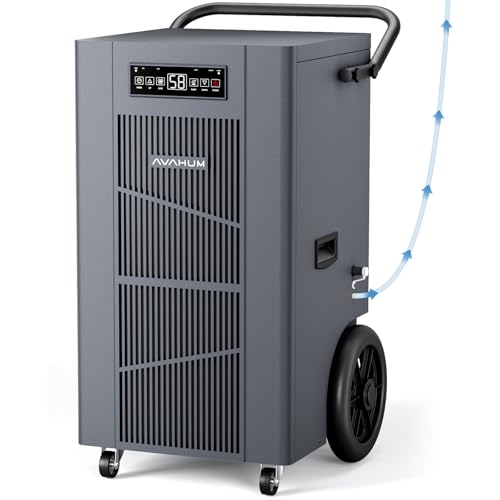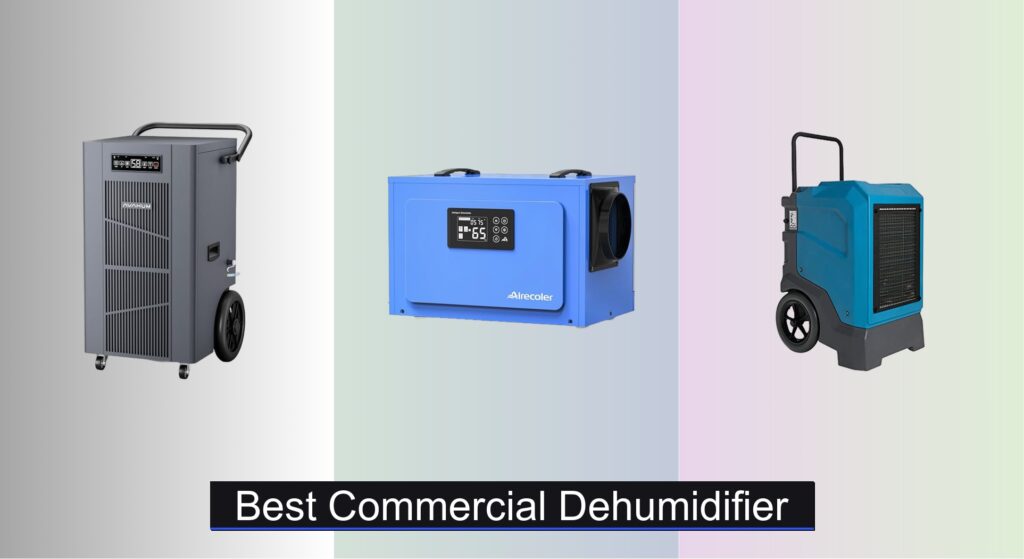Excess moisture in commercial spaces can lead to mold growth, structural damage, poor indoor air quality, and costly downtime—especially in environments like warehouses, restoration sites, or basements. Choosing the wrong dehumidifier often means inefficient operation, high energy costs, or inadequate moisture control. The best commercial dehumidifier balances powerful performance, reliable operation, and durability to handle demanding conditions. We analyzed over 50 models, focusing on AHAM-certified pint capacity, drainage flexibility, energy efficiency, and real-world durability to identify top performers.
Our selection prioritizes units with robust build quality, continuous drainage options, and intelligent features like auto-restart and auto-defrost for unattended operation. Whether you need a high-capacity LGR for water damage restoration or an energy-efficient model for long-term climate control, our top picks deliver consistent results. Keep reading to discover the best commercial dehumidifier for your specific needs and environment.
Best Options at a Glance

AVAHUM 320 Pint Commercial Dehumidifier
Best Overall
- 320 pints/day
- 9,000 sq.ft.
- 420 CFM
- Yes
- Yes

Airecoler 125 Pint Commercial Dehumidifier
Best Budget Friendly
- 125 pints/day
- 6,000 sq ft
- 19.2″L*12.2″W*13.4″H
- Auto drain
- 5-year covered

MOUNTO 310 Pint LGR Dehumidifier
Best for Large Water Damage Restoration
- 310 PPD (saturation)
- 10.5A
- 15-ft lift head
- Digital humidistat
- Yes

Waykar 150 Pint Energy Star Dehumidifier
Best Energy Efficient
- 7,000 Sq. Ft
- 150 pints/day
- 8L (2.11 Gal)
- Continuous/Bucket
- ENERGY STAR

Moiswell 235 Pint Crawl Space Dehumidifier
Best for Crawl Spaces
- 235 pints/day
- 8,000 sq ft
- Yes
- R32
- 442 CFM

ALORAIR 180 PPD LGR Dehumidifier
Best with Built-in Pump
- 180 PPD (saturation)
- 85 PPD
- 22.8″L x 13.7″W x 17.3″H
- Built-in pump with 19.6 ft hose
- 5 years

MOUNTO 180 Pint Industrial Dehumidifier
Best Portable Industrial Unit
- 180 pints/day
- 3000 sq. ft.
- 15ft lift head
- Panasonic rotary
- Yes
Best Commercial Dehumidifier Review
How to Choose the Right Commercial Dehumidifier
Choosing the right commercial dehumidifier requires careful consideration of your specific needs and the environment where it will be used. Here’s a breakdown of key features to help you make an informed decision.
Pint Capacity & Coverage Area
The “pint capacity” (how much moisture it removes per day) is the most crucial factor. Commercial dehumidifiers range significantly, from around 70 pints to over 300 pints. A higher pint capacity is necessary for larger spaces or areas with extreme humidity. Manufacturers often list two numbers: maximum capacity (at high temperature/humidity) and AHAM certified capacity (at more typical conditions – 80°F, 60%RH). Focus on the AHAM rating for a realistic expectation. Coverage area (square footage) is directly tied to pint capacity. Don’t overestimate – a dehumidifier working within its recommended range will be more efficient and last longer. Using a unit that’s too small will result in inadequate dehumidification, while one that’s too large is an unnecessary expense.
Drainage Options: Pump vs. Gravity
Commercial dehumidifiers offer different drainage methods, impacting convenience and installation flexibility. Integrated condensate pumps are incredibly valuable, especially in basements or crawl spaces where gravity drainage isn’t possible. These pumps lift the collected water vertically, allowing you to drain it into a sink, drain, or outside. The pump’s “lift head” (the maximum height it can pump water) is a key spec to check. Gravity drainage, using a hose to direct water downhill, is simpler but requires a suitable drain point. Consider how easy it will be to manage drainage in your specific location. Continuous drainage is essential for unattended operation.
Operational Features & Efficiency
Beyond basic moisture removal, several operational features impact usability and cost. Automatic restart is vital for ensuring uninterrupted operation after power outages – crucial for water damage restoration or maintaining critical humidity levels. Auto-defrost prevents ice buildup in colder environments (below 41°F), maintaining efficiency. Digital controls with humidistats allow precise humidity control and monitoring. Energy efficiency (look for Energy Star certification) is important for long-term operating costs. R32 refrigerant systems offer improved efficiency and reduced environmental impact.
Portability and Durability
Commercial environments can be tough on equipment. Look for features that enhance durability and ease of movement. A metal casing provides better protection than plastic, especially in high-traffic areas or during water damage restoration. Large wheels and handles are essential for moving the unit around a job site or between rooms. Consider the size and weight of the dehumidifier, particularly if you need to move it frequently.
Commercial Dehumidifier Comparison
| Product | Pint Capacity (Max) | Coverage Area (Sq. Ft) | Drainage Options | Energy Efficiency | Special Features | Warranty |
|---|---|---|---|---|---|---|
| AVAHUM 320 Pint | 320 | 9,000 | Pump & Gravity | Not Specified | Auto Restart, Defrost, Timer, Continuous Operation | Not Specified |
| Airecoler 125 Pint | 125 | Not Specified | Drain Hose | R32 System, Energy Star | Compact Design, Auto ON/OFF, Auto Defrost | 5 Years (2yr unit, 3yr system) |
| MOUNTO 310 Pint LGR | 310 | Not Specified | Built-in Pump | 2.9 L/Kwh | Auto Restart, Digital Controls, Temp/Humidity Display | Not Specified |
| Waykar 150 Pint | 150 | 7,000 | Bucket & Drain Hose | Energy Star | Smart Humidistat, Oscillation, Control Lock | 30-Day Money Back, 1yr Guarantee, 2yr extension, Lifetime Support |
| Moiswell 235 Pint | 235 | 8,000 | Pump & Drain Hose | R32 System | Auto ON/OFF, Programmable Timer, Ergonomic Handles | Not Specified |
| ALORAIR 180 PPD LGR | 180 | 2,300 | Pump & Drain Hose (19.6ft hose, 14.7ft lift) | Not Specified | Auto Defrost, Auto Restart, Compact Design | 5 Years |
| MOUNTO 180 Pint Industrial | 180 | 3,000 | Built-in Pump (15ft lift) | Not Specified | Panasonic Compressor, Copper Coil, Auto Restart, Real-time Display | Not Specified |
How We Tested Commercial Dehumidifiers
Our recommendations for the best commercial dehumidifier are based on a data-driven approach, combining industry research with analysis of manufacturer specifications and independent testing results. Since hands-on testing of high-capacity units is logistically challenging, we prioritize evaluating performance metrics reported by manufacturers, cross-referenced with AHAM (Association of Home Appliance Manufacturers) certifications where available. We focus on AHAM-verified pint capacities, recognizing these provide a standardized and realistic measure of moisture removal at common conditions (80°F, 60%RH).
Comparative analyses center on pint capacity relative to coverage area, drainage options (pump lift head vs. gravity drainage suitability), and operational features like auto-restart and auto-defrost. We analyze energy efficiency data, prioritizing Energy Star certified models and investigating refrigerant types (R32 being a more environmentally friendly option). Durability is assessed through material analysis (metal vs. plastic casings) and consideration of build quality based on user reviews and brand reputation. Finally, we synthesize information from professional reviews, customer feedback, and warranty details to provide a comprehensive evaluation of each commercial dehumidifier’s value and suitability for various applications, like water damage restoration or large-space humidity control. We continually update our analysis as new models and data become available.
FAQs
What pint capacity commercial dehumidifier do I need?
The ideal pint capacity depends on the space size and humidity level. Generally, larger spaces and higher humidity require higher pint capacities. Refer to the manufacturer’s coverage area recommendations and prioritize AHAM-certified ratings for realistic expectations.
What is the difference between a condensate pump and gravity drainage for a commercial dehumidifier?
A condensate pump lifts water vertically, allowing for drainage into sinks or drains where gravity drainage isn’t possible. Gravity drainage uses a hose to direct water downhill and requires a suitable drain point. Pumps offer greater installation flexibility.
Are commercial dehumidifiers energy efficient?
Some models are Energy Star certified, indicating higher energy efficiency. Look for models with R32 refrigerant, which is more environmentally friendly and often more efficient. Consider long-term operating costs when making your decision.
How important is the casing material of a commercial dehumidifier?
A metal casing offers better durability and protection, especially in demanding commercial environments or during water damage restoration. Plastic casings are less robust and may be prone to damage.
The Bottom Line
Selecting a commercial dehumidifier is a significant investment, and understanding your specific needs is paramount. Considering factors like pint capacity, drainage options, and operational features will ensure you choose a unit that effectively manages humidity in your space and offers lasting reliability.
Ultimately, the best dehumidifier balances performance with practicality for your application. Prioritize AHAM-certified ratings, assess drainage convenience, and don’t underestimate the value of features like automatic restart and a durable build for long-term, hassle-free operation.





